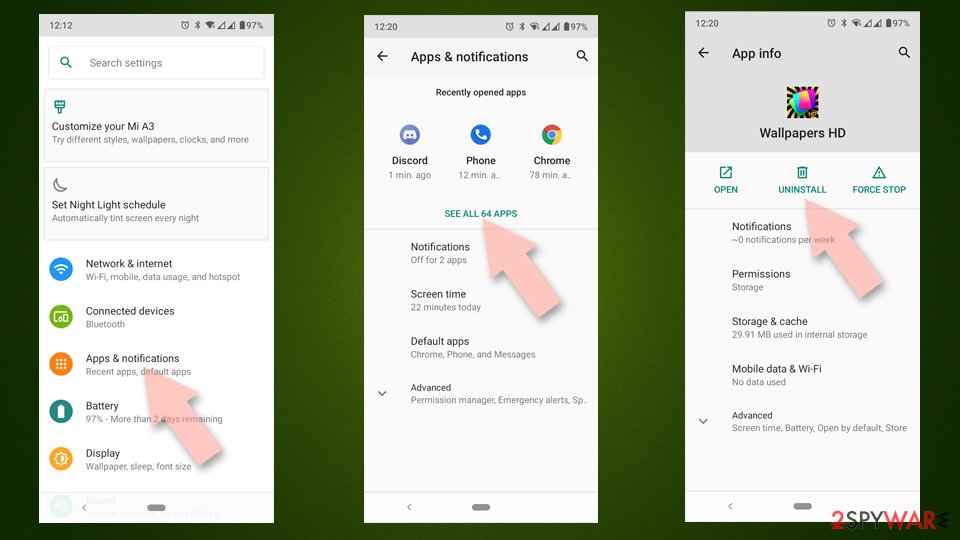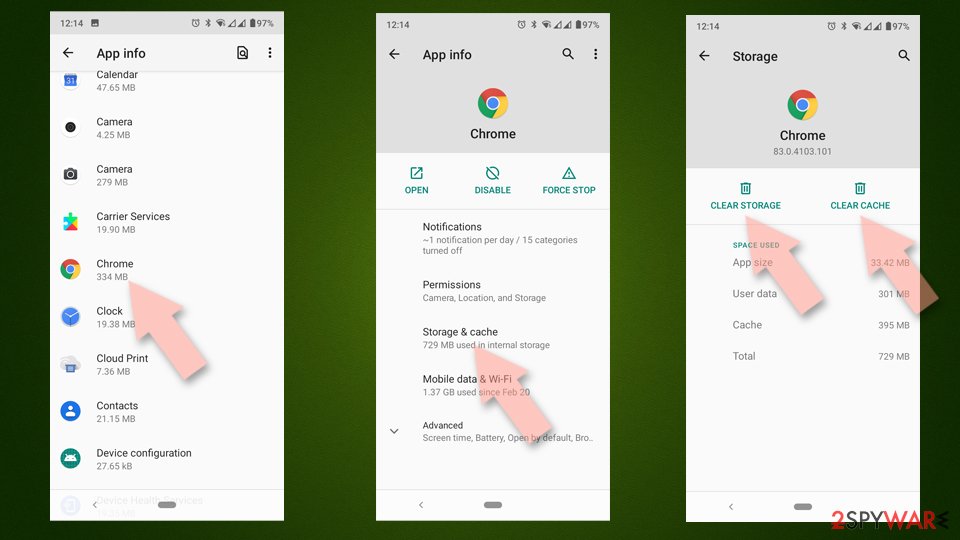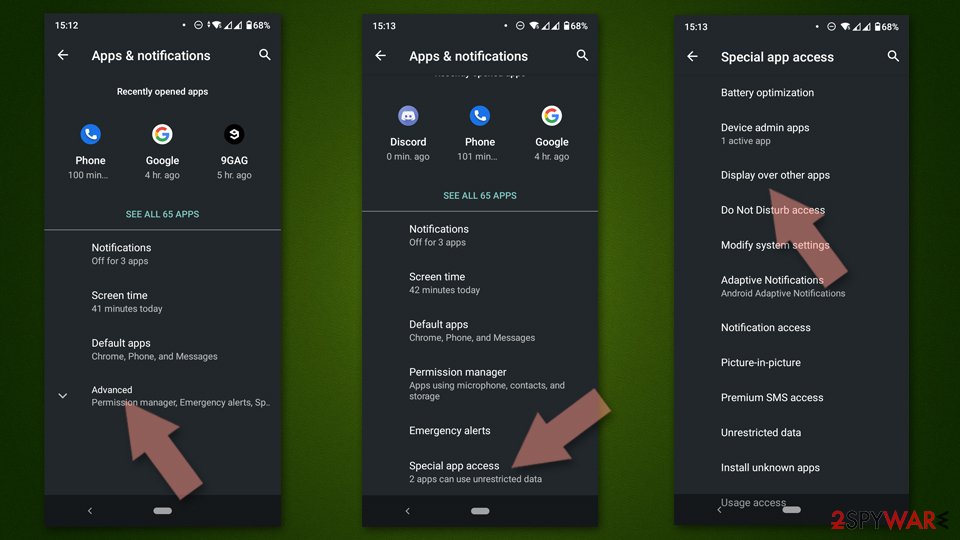Liffsandupa.xyz ads (Free Instructions)
Liffsandupa.xyz ads Removal Guide
What is Liffsandupa.xyz ads?
Liffsandupa.xyz is a malicious website created to scam users
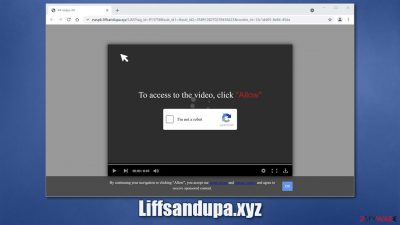
Liffsandupa.xyz is used by crooks as a tool to make users subscribe to notifications and then deliver ads to them constantly. In most cases, users do not visit this site intentionally while browser the web on Google Chrome, Mozilla Firefox, or any other browsers, but are rather redirected to it from somewhere else (an activity that can also be caused by adware[1] or any only other potentially unwanted program/malware).
Upon entering the website, users would be immediately shown some type of fraudulent message; for example, that they need to verify they are not robots or that a video is about to be played and similar. These messages serve as a reason for users to press the “Allow” button within the notification prompt – an action that then allows the Liffsandupa.xyz to send all types of information via push notifications.
These pop-ups can appear at random times (although this activity does not usually start immediately) above all the other programs currently run on Windows or Mac systems. Likewise, the activity is very prominent on mobile devices using iOS or Android operating systems.
Notifications often include various insecure content: from links to sponsored websites to straight-out scams. It is recommended to avoid interacting with these pop-ups and click on links, as users might be redirected to a malicious website where malware could be downloaded and installed automatically under certain circumstances.
If you have been a victim of such a scam, you should not fret, as there is a way to undo it. Similar to how you allow the notifications to be shown, you can block this permission via the web browser settings. We explain it in our step-by-step removal guide below.
| Name | Liffsandupa.xyz |
|---|---|
| Type | Push notifications, pop-ups, ads |
| Distribution | The unwanted ad activity starts as soon as the “Allow” button is pressed in the notification prompt |
| Symptoms | Intrusive pop-ups from the site will be shown directly on users' desktops |
| Risks | Installation of potentially unwanted programs or malware, data loss, information leak, financial losses due to encountered scams |
| Removal | Notifications can be disabled via the browser settings; in case you experience more ads and redirects to suspicious sites, you should also get rid of adware – use security software for a quick elimination |
| Additional steps | Cleaning web browsers is just as important when dealing with potentially unwanted programs, so do so by following the instructions below or use FortectIntego as an automatic fix |
A deep-dive into Liffsandupa.xyz scam
If you would enter the URL of Liffsandupa.xyz into the Omnibox of your browser, you would be taken something that looks like a regular website about sports. A generic picture of players from various sports are present, which also incorporates the following message:
Get The Latest Sports Updates From Around The World.
Seems like it could be useful – there are plenty of sports fans out there. However, if you look closely, there is no actual sports content or any other information on the site available but instead, people are asked to allow push notifications to allegedly receive it. This is just a pretense for visitors to click that “Allow” button within the notification prompt, and the website straight out lies about how it works in the first place.
If you check the small print at the bottom, you would see a notice which states:
By Continuing Your Navigation Or Clicking “Allow”, You Accept Our Terms Of Use And Privacy Policy And Agree To Receive Sponsored Content.
Nevertheless, users rarely check sections like a privacy policy or messages like these. In other words, those who press the allow button automatically give permission for the website to show notifications filled with sponsored content, which sometimes may be insecure.
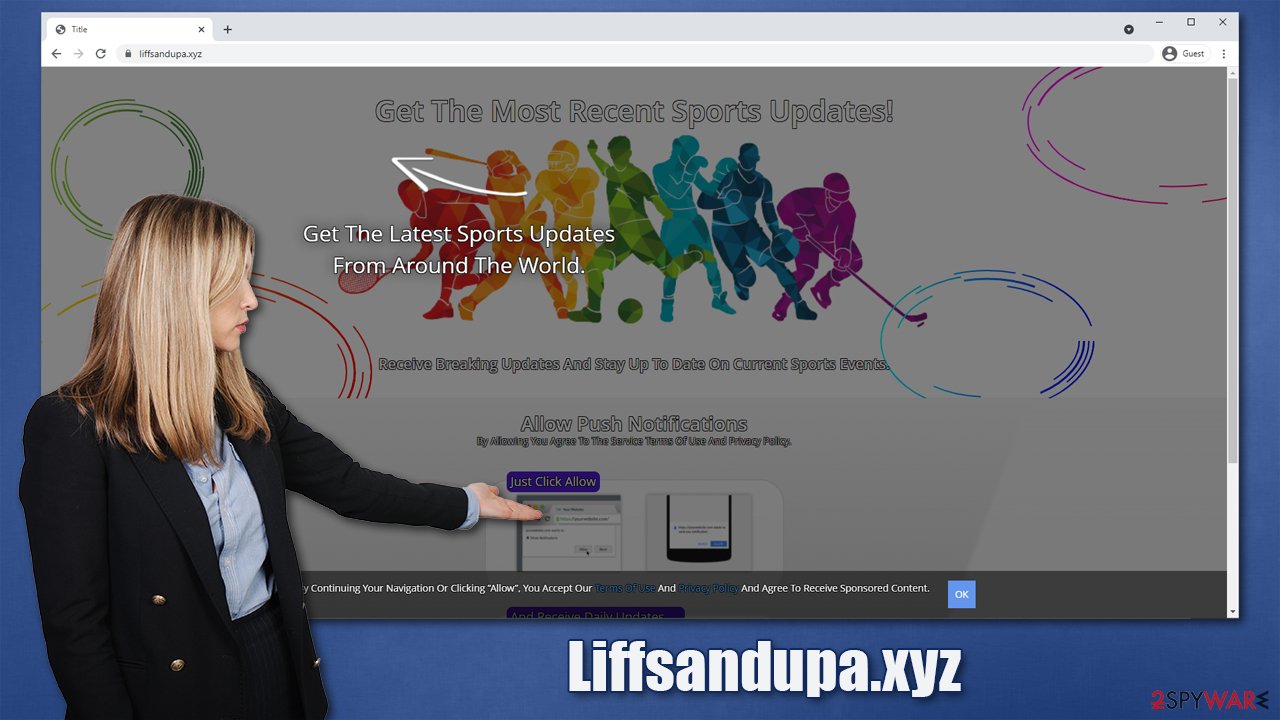
As a matter of fact, most users do not see this version of the website in the first place. Instead, once redirected, they see a fake message that claims various things, and none of which are true. Here are a few examples you might encounter:
- Click Allow to watch the video
- Click Allow to confirm that you are not a robot
- Your file is ready to download. Press ALLOW to continue
- Click “Allow” to close this window
- If you are 18+, click Allow, etc.
As evident, these are all lies, and there is no content to explore after the notification prompt is interacted with. Instead, users are forwarded to similar websites – such as Romancedating.top, Flatcapspriggy.cam, or Allhugeblog.com – where they are asked to enable notifications once more. If they oblige, their screens would be filled with various dangerous content constantly.
Thus, do not interact with push notification prompts, no matter what is said in the background. If you already have, you can revert this decision after accessing the notification settings within your browser. Follow the steps in the next section.
Learn to stop the intrusive pop-ups
There are a couple of reasons why users don't know how to remove Liffsandupa.xyz notifications from their computers. They might think that the activity is caused by a virus rather than the browser. This happens because pop-ups usually don't start showing up immediately after the “Allow” button is pressed within the prompt but much later. Additionally, some people might agree to these notifications by accident after being redirected several times from another website.
In any case, it is not difficult to prevent a website from delivering you notifications – here's how:
Google Chrome (desktop):
- Open Google Chrome browser and go to Menu > Settings.
- Scroll down and click on Advanced.
- Locate the Privacy and security section and pick Site Settings > Notifications.
- Look at the Allow section and look for a suspicious URL.
- Click the three vertical dots next to it and pick Block. This should remove unwanted notifications from Google Chrome.
![Stop notifications on Chrome PC 2 Stop notifications on Chrome PC 2]()
Google Chrome (Android):
- Open Google Chrome and tap on Settings (three vertical dots).
- Select Notifications.
- Scroll down to the Sites section.
- Locate the unwanted URL and toggle the button to the left (Off setting).
![Stop notifications on Chrome Android Stop notifications on Chrome Android]()
Mozilla Firefox:
- Open Mozilla Firefox and go to Menu > Options.
- Click on Privacy & Security section.
- Under Permissions, you should be able to see Notifications. Click the Settings button next to it.
- In the Settings – Notification Permissions window, click on the drop-down menu by the URL in question.
- Select Block and then click on Save Changes. This should remove unwanted notifications from Mozilla Firefox.
![Stop notifications on Mozilla Firefox 2 Stop notifications on Mozilla Firefox 2]()
Safari:
- Click on Safari > Preferences…
- Go to Websites tab and, under General, select Notifications.
- Select the web address in question, click the drop-down menu and select Deny.
![Stop notifications on Safari Stop notifications on Safari]()
MS Edge:
- Open Microsoft Edge, and click the Settings and more button (three horizontal dots) at the top-right of the window.
- Select Settings and then go to Advanced.
- Under Website permissions, pick Manage permissions and select the URL in question.
- Toggle the switch to the left to turn notifications off on Microsoft Edge.
![Stop notifications on Edge 2 Stop notifications on Edge 2]()
MS Edge (Chromium):
- Open Microsoft Edge, and go to Settings.
- Select Site permissions.
- Go to Notifications on the right.
- Under Allow, you will find the unwanted entry.
- Click on More actions and select Block.
![Stop notifications on Edge Chromium Stop notifications on Edge Chromium]()
Internet Explorer:
- Open Internet Explorer, and click on the Gear icon at the top-right of the window.
- Select Internet options and go to the Privacy tab.
- In the Pop-up Blocker section, click on Settings.
- Locate web address in question under Allowed sites and pick Remove.
![Stop notifications on Internet Explorer Stop notifications on Internet Explorer]()
What is adware and why should you remove it
While adware is not directly related to push notification activity, it is one of the reasons why users experience random redirects to ad-filled or phishing[2] websites more frequently than those who are not infected. It is also commonly used to track user data and share it with third parties. In other words, it brings nothing to users but negative experiences and even puts their computer security and personal privacy at risk. This is why it is important to check your system for adware carefully.
Adware is commonly spread within software bundle packages, hence most people don't even know they have it installed. Note that it can come as a browser extension or a program installed on the system, so you should check both places. If you need help with this process, we provide detailed instructions below.
Nonetheless, the easiest way to look for adware is by scanning your device with anti-malware software, for example, SpyHunter 5Combo Cleaner, Malwarebytes. It would also check for malware and remove all the malicious components automatically for you. Also, don't forget to clean your browsers from items such as cookies,[3] caches, and other web data. Otherwise, the tracking activity might continue, or you might continue being exposed to ads.
To do this without too much effort, we recommend using FortectIntego, although we also provide details on how to clean browsers manually. The tool could also help you repair system files if malware managed to damage them.
Getting rid of Liffsandupa.xyz ads. Follow these steps
Uninstall from Android
Uninstall unwanted programs from Android device:
- Go to Settings -> Apps/Applications.
- Expand the full list of the installed apps.
- Scroll through the list and tap on a suspicious application once.
- Tap on it and select Uninstall.

- Reboot the device.
Clear Storage and data files on Android from Google Chrome or other apps:
- Go to Settings > Apps/Applications.
- Expand the full list of the installed apps.
- Tap on Chrome and select Storage & cache.
- Clear storage and clear cache of the app.

If you are seeing ads on top of other apps but are not sure what is causing it, perform the following steps:
- Go to Apps/Applications.
- Tap Advanced.
- Select Special App access.
- Tap on Display over other apps.

- Eliminate apps with these access rights enabled.
Uninstall from Windows
Instructions for Windows 10/8 machines:
- Enter Control Panel into Windows search box and hit Enter or click on the search result.
- Under Programs, select Uninstall a program.

- From the list, find the entry of the suspicious program.
- Right-click on the application and select Uninstall.
- If User Account Control shows up, click Yes.
- Wait till uninstallation process is complete and click OK.

If you are Windows 7/XP user, proceed with the following instructions:
- Click on Windows Start > Control Panel located on the right pane (if you are Windows XP user, click on Add/Remove Programs).
- In Control Panel, select Programs > Uninstall a program.

- Pick the unwanted application by clicking on it once.
- At the top, click Uninstall/Change.
- In the confirmation prompt, pick Yes.
- Click OK once the removal process is finished.
Delete from macOS
Remove items from Applications folder:
- From the menu bar, select Go > Applications.
- In the Applications folder, look for all related entries.
- Click on the app and drag it to Trash (or right-click and pick Move to Trash)

To fully remove an unwanted app, you need to access Application Support, LaunchAgents, and LaunchDaemons folders and delete relevant files:
- Select Go > Go to Folder.
- Enter /Library/Application Support and click Go or press Enter.
- In the Application Support folder, look for any dubious entries and then delete them.
- Now enter /Library/LaunchAgents and /Library/LaunchDaemons folders the same way and terminate all the related .plist files.

Remove from Google Chrome
Delete malicious extensions from Google Chrome:
- Open Google Chrome, click on the Menu (three vertical dots at the top-right corner) and select More tools > Extensions.
- In the newly opened window, you will see all the installed extensions. Uninstall all the suspicious plugins that might be related to the unwanted program by clicking Remove.

Clear cache and web data from Chrome:
- Click on Menu and pick Settings.
- Under Privacy and security, select Clear browsing data.
- Select Browsing history, Cookies and other site data, as well as Cached images and files.
- Click Clear data.

Change your homepage:
- Click menu and choose Settings.
- Look for a suspicious site in the On startup section.
- Click on Open a specific or set of pages and click on three dots to find the Remove option.
Reset Google Chrome:
If the previous methods did not help you, reset Google Chrome to eliminate all the unwanted components:
- Click on Menu and select Settings.
- In the Settings, scroll down and click Advanced.
- Scroll down and locate Reset and clean up section.
- Now click Restore settings to their original defaults.
- Confirm with Reset settings.

Remove from Microsoft Edge
Delete unwanted extensions from MS Edge:
- Select Menu (three horizontal dots at the top-right of the browser window) and pick Extensions.
- From the list, pick the extension and click on the Gear icon.
- Click on Uninstall at the bottom.

Clear cookies and other browser data:
- Click on the Menu (three horizontal dots at the top-right of the browser window) and select Privacy & security.
- Under Clear browsing data, pick Choose what to clear.
- Select everything (apart from passwords, although you might want to include Media licenses as well, if applicable) and click on Clear.

Restore new tab and homepage settings:
- Click the menu icon and choose Settings.
- Then find On startup section.
- Click Disable if you found any suspicious domain.
Reset MS Edge if the above steps did not work:
- Press on Ctrl + Shift + Esc to open Task Manager.
- Click on More details arrow at the bottom of the window.
- Select Details tab.
- Now scroll down and locate every entry with Microsoft Edge name in it. Right-click on each of them and select End Task to stop MS Edge from running.

If this solution failed to help you, you need to use an advanced Edge reset method. Note that you need to backup your data before proceeding.
- Find the following folder on your computer: C:\\Users\\%username%\\AppData\\Local\\Packages\\Microsoft.MicrosoftEdge_8wekyb3d8bbwe.
- Press Ctrl + A on your keyboard to select all folders.
- Right-click on them and pick Delete

- Now right-click on the Start button and pick Windows PowerShell (Admin).
- When the new window opens, copy and paste the following command, and then press Enter:
Get-AppXPackage -AllUsers -Name Microsoft.MicrosoftEdge | Foreach {Add-AppxPackage -DisableDevelopmentMode -Register “$($_.InstallLocation)\\AppXManifest.xml” -Verbose

Instructions for Chromium-based Edge
Delete extensions from MS Edge (Chromium):
- Open Edge and click select Settings > Extensions.
- Delete unwanted extensions by clicking Remove.

Clear cache and site data:
- Click on Menu and go to Settings.
- Select Privacy, search and services.
- Under Clear browsing data, pick Choose what to clear.
- Under Time range, pick All time.
- Select Clear now.

Reset Chromium-based MS Edge:
- Click on Menu and select Settings.
- On the left side, pick Reset settings.
- Select Restore settings to their default values.
- Confirm with Reset.

Remove from Mozilla Firefox (FF)
Remove dangerous extensions:
- Open Mozilla Firefox browser and click on the Menu (three horizontal lines at the top-right of the window).
- Select Add-ons.
- In here, select unwanted plugin and click Remove.

Reset the homepage:
- Click three horizontal lines at the top right corner to open the menu.
- Choose Options.
- Under Home options, enter your preferred site that will open every time you newly open the Mozilla Firefox.
Clear cookies and site data:
- Click Menu and pick Settings.
- Go to Privacy & Security section.
- Scroll down to locate Cookies and Site Data.
- Click on Clear Data…
- Select Cookies and Site Data, as well as Cached Web Content and press Clear.

Reset Mozilla Firefox
If clearing the browser as explained above did not help, reset Mozilla Firefox:
- Open Mozilla Firefox browser and click the Menu.
- Go to Help and then choose Troubleshooting Information.

- Under Give Firefox a tune up section, click on Refresh Firefox…
- Once the pop-up shows up, confirm the action by pressing on Refresh Firefox.

Delete from Safari
Remove unwanted extensions from Safari:
- Click Safari > Preferences…
- In the new window, pick Extensions.
- Select the unwanted extension and select Uninstall.

Clear cookies and other website data from Safari:
- Click Safari > Clear History…
- From the drop-down menu under Clear, pick all history.
- Confirm with Clear History.

Reset Safari if the above-mentioned steps did not help you:
- Click Safari > Preferences…
- Go to Advanced tab.
- Tick the Show Develop menu in menu bar.
- From the menu bar, click Develop, and then select Empty Caches.

How to prevent from getting adware
Access your website securely from any location
When you work on the domain, site, blog, or different project that requires constant management, content creation, or coding, you may need to connect to the server and content management service more often. The best solution for creating a tighter network could be a dedicated/fixed IP address.
If you make your IP address static and set to your device, you can connect to the CMS from any location and do not create any additional issues for the server or network manager that needs to monitor connections and activities. VPN software providers like Private Internet Access can help you with such settings and offer the option to control the online reputation and manage projects easily from any part of the world.
Recover files after data-affecting malware attacks
While much of the data can be accidentally deleted due to various reasons, malware is one of the main culprits that can cause loss of pictures, documents, videos, and other important files. More serious malware infections lead to significant data loss when your documents, system files, and images get encrypted. In particular, ransomware is is a type of malware that focuses on such functions, so your files become useless without an ability to access them.
Even though there is little to no possibility to recover after file-locking threats, some applications have features for data recovery in the system. In some cases, Data Recovery Pro can also help to recover at least some portion of your data after data-locking virus infection or general cyber infection.







